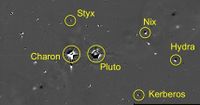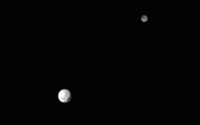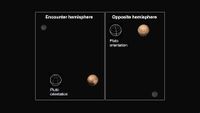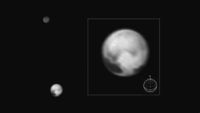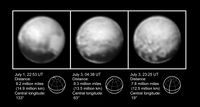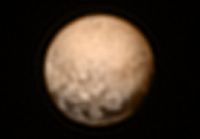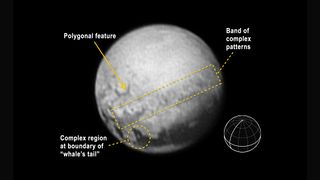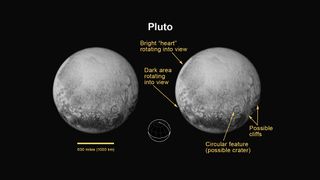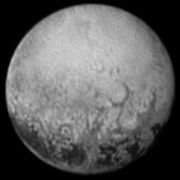نيو هورايزونز
 المسبار الفضائي نيو هورايزونز. | |
| طبيعة المهمة | التحليق حول پلوتو |
|---|---|
| المشغل | ناسا |
| COSPAR ID | 2006-001A |
| SATCAT № | 28928 |
| الموقع الإلكتروني | pluto www.nasa.gov |
| مدة المهمة | المهمة الأساسية: 9.5 سنوات |
| خصائص المركبة الفضائية | |
| المصنع | معمل الفيزياء التطبيقية · معهد أبحاث ساوثوست |
| وزن الإطلاق | 478 kilograms (1,054 lb) |
| الطاقة | 228 واط |
| بداية المهمة | |
| تاريخ الإطلاق | 19 يناير 2006 19:00 UTC (19 years, 3 months and 3 days ago) |
| الصاروخ | أطلس 5 551 |
| موقع الإطلاق | كيپ كناڤرال SLC-41 |
| المقاول | International Launch Services |
| Invalid value for parameter "type" | |
| Invalid parameter | 20 يناير 2006 04:00 UTC (19 years, 3 months and 2 days ago) |
| "distance" should not be set for missions of this nature | 189.916 كم |
| Invalid value for parameter "type" | |
| Invalid parameter | 13 يونيو 2006 04:05 UTC (18 years, 10 months and 9 days ago) |
| "distance" should not be set for missions of this nature | 101.867 كم |
| Invalid value for parameter "type" | |
| Invalid parameter | 28 فبراير 2007 05:43:40 UTC (18 years, 1 months and 25 days ago) |
| "distance" should not be set for missions of this nature | 2.300.000 كم |
| Invalid value for parameter "type" | |
| Invalid parameter | 14 يوليو 2015 11:49:57 UTC |
| "distance" should not be set for missions of this nature | 12.500 كم |
 | |
نيو هورايزونز New Horizons، هو مسبار فضائي بين الكواكب أُطلق في 19 يناير 2006، كجزء من برنامج الجبهات الجديدة التابع لناسا. بناه معمل الفيزياء التطبيقية ومعهد أبحاث ساوثوست، بمساعدة فريق تحت قيادة س. آلان سترن، تم إطلاق المسبار لدراسة كوكب پلوتو، أقماره وحزام كيپلر، القيام بالتحليق داخل نظام كوكب پلوتو وواحداً أو أكثر من أجرام حزام كيپلر.[1][2][3][4]
نيو هواريزونز هو نتاج سنوات عديدة من العمل على مهمات لإرسال سفينة فضاء إلى پلوتو، بدأت في 1990 مع پلوتو 350، مع آلان سترن وفران باگنال من "پلوتو أندرگراوند"، وعام 1992 مع پلوتو فاست فلايباي التابع لمعمل الاحتراق النفاث؛ الأخير مستوحى من طابع البريد الأمريكي الذي وصف پلوتو على أنه "لم يتكشف بعد". تهدف هذه المهمة الطموحة إلى إرسال سفينة فضاء خفيفة الوزن منخفضة التكلفة إلى پلوتو، وأضيف إليه لاحقاً مهمة أجرام حزام كيپلر والتي سميت پلوتو كيپلر إكسپرس. إلا أنه، وبسبب الدعم المحدود من ناسا والميزانية المتزايدة، تم إلغاء المشروعين معاً عام 2000.
في 15 يناير 2015، بدأت مركبة الفضاء نيو هواريزونز مرحلة الاقتراب من پلوتو. في 14 يوليو 2015 الساعة 11:49 حسب التوقيت العالمي، حلقت نيو هواريزونز على بعد 7.800 كم من سطح پلوتو.[5] وكانت بذلك أول مركبة فضاء تستكشف پلوتو.[4]
في 14 يوليو 2015، عند الساعة 11:49 حسب التوقيت العالمي، حلق المسبار على ارتفاع 12.500 كم فوق سطح پلوتو،[6][5] مما يجعله أو لمركبة فضائية تستكشف الكوكب القزم.[4][7] في 12 أكتوبر 2016، في الساعة 21:48 حسب التوقيت العالمي، وصلت آخر بيانات مسجلة لتحليق المسبار فوق پلوتو.[8] بعد إنتهاؤه من التحليق فوق پلوتو،[9] قام نيو هورايزونز بمناورة للتحليق فوق للجرم أولتيما تولى، ضمن حزام كايپر،[10][11][12] وأتم ذلك في 1 يناير 2019،[13] عندما كان على بعد 43.4 وحدة فلكية من الشمس.[10][11] في أغسطس 2018، أعلنت ناسا نتائج أليس الخاصة بالمسبار نيو هورايزونز لتأكيد وجود "جدار هيدروجيني على الأطراف الخارجية للمجموعة الشمسية. تم التحقق من هذا "الجدار" عام 1992 بواسطة مركبة الفضاء ڤويدجر.[14][15]
التاريخ
پلوتو أندرگراوند، پلوتو 350 ومارينير مارك 2

طابق البريد الأمريكي وپلوتو فاس فلايباي

حزام كيپر وپلوتو كيپلر إكسپرس والإلغاء
آلان سترن ونيو هواريزونز

ملف المهمة
الأهداف

New Horizons • (486958) 2014 MU69 • Earth • 132524 APL • Jupiter • Pluto
- خريطة تركيب سطح پلوتو وشارون
- معرفة الخصائص الجيولوجية والمورفولوجية لپلوتو وشارون
- معرفة خصائص الغلاف الجوي لپلوتو ومعدل تبدده
- البحث عن غلاف جوي حول شارون
- خريطة لدرجات حرارة السطح على پلوتو وشارون
- البحث عن حلقات وأقمار إضافية حول پلوتو
- عقد استقصاءات مشابهة في واحد أو أكثر من أجرام حزام كيپلر
التصميم والانشاء
النظم الفرعية لمركبة الفضاء
التحكم في الاحتراق والارتفاع
الطاقة
حاسوب الرحلة
الاتصالات وتداول البيانات

الحمولة العلمية
كاميرا الاستطلاع طويل المدى
الرياح الشمسية في پلوتو
التحقق العلمي بواسطة مطياف الجسيمات الطاقوية لپلوتو
أليس
مجهر رالف
مكافح الغبار الدارس
التجربة العلمية الراديوية
الرحلة إلى پلوتو
الإطلاق
النظام الشمسي الداخلي
تصحيحات المسار
اختبارات التحليق ومدار المريخ
الكويكب 132524 APL
أول رؤية لپلوتو
الوصول للمشترى
أقمار المشترى
النظام الشمسي الخارجي
أهداف نپتون المحتملة
رصد پلوتو وشارون 2013–14
الاقتراب من پلوتو

خلل البرمجيات
الوصول لپلوتو
الأهداف
الاقتراب
رصد السواتل الصغرى
الوضع الحالي
The New Horizons spacecraft flew closest to Charon on July 14, 2015 12:03:50 UTC (08:03:50 EDT).[1]
- The spacecraft currently travels at 14.52 km/s (9.02 mi/s; 3.06 AU/a; 0.00839 AU/d) relative to the Sun and at 13.78 km/s (8.56 mi/s; 2.91 AU/a; 0.00796 AU/d) relative to Pluto.
- Radio signals take four and a half hours to travel between the spacecraft and Earth.[16]
- The brightness of the Sun from the spacecraft is magnitude −19.2.[17]
- New Horizons is heading in the direction of the constellation Sagittarius.[17]
- The latest news and photos from the probe are posted on NASA's mission website.[1]
الأهداف المستقبلية للمهمة
مهمة أجرام حزام كيپلر
خلفية الهدف
البحث
أجرام حزام كيپلر الموائمة
ما بعد مهمة أجرام حزام كيپلر
معرض الصور
صور الإطلاق
The Atlas V 551 rocket, used to launch New Horizons, being processed a month before launch.
View of Cape Canaveral Launch Complex 41, with the Atlas V carrying New Horizons on the pad.
NASA TV footage of New Horizons' launch from Cape Canaveral. (4:00)
صور التحليق حول المشترى
LORRI images of Jupiter's rings. The top image was taken on approach to Jupiter, whereas the bottom image was taken on departure, illuminated by the Sun.
A composite false-color image of Oval BA, otherwise known as the "Little Red Spot", using New Horizons' LORRI and the Hubble Space Telescope's WFPC2.
An MVIC image of Jupiter's equatorial atmosphere, showing Buoyancy waves that travel at 100m/s faster than surrounding clouds.
صور أقمار المشترى
A LORRI image of Io, taken while New Horizons passed through its penumbra. Volcanic plumes, lava and aurora are all visible in this image.
New Horizons view of Europa. One of the goals of New Horizons at Europa was to examine the "nature of the icy crust and the forces that have deformed it".
New Horizons' view of Ganymede
صور مرحلة الاقتراب من پلوتو
May 2015: Pluto as seen by LORRI during AP2 from a distance of 75 million km away[21]
June 2015: Pluto system, taken by the New Horizons space probe.
June 2015: Pluto (left) and its moon Charon, taken by the New Horizons space probe.
خط زمني
| المرحلة | التاريخ | الحدث | الوصف | المصادر |
|---|---|---|---|---|
| مرحلة ما قبل الاطلاق | 8 يناير 2001 | Proposal team meets face-to-face for the first time at the Johns Hopkins University Applied Physics Laboratory | [22] | |
| February 5, 2001 | اختيار اسم نيو هواريزنوز. | [22][23] | ||
| 6 أبريل 2001 | تقديم مقترح نيو هواريزونز لناسا. | It was one of five proposals submitted, which were later narrowed to two for Phase A study: POSSE (Pluto and Outer Solar System Explorer) and New Horizons. | [22] | |
| 29 نوفمبر 2001 | اختيار نيوهواريزون من قبل ناسا. | Started Phase B study. | [24] | |
| مارس 2002 | تصفير الميزانية من قبل إدارة بوش، وتم التخلي عنها لاحقاً | [25] | ||
| 13 يونيو 2005 | المركبة الفضائية تغادر معمل الفيزياء التطبيقية للاختبار النهائي. | Spacecraft undergoes final testing at Goddard Space Flight Center (GSFC). | [27] | |
| 24 سبتمبر 2005 | نقل المركبة الفضائية إلى كيپ كناڤرال | It was moved through Andrews Air Force Base aboard a C-17 Globemaster III cargo aircraft. | [28] | |
| 17 ديسمبر 2005 | المركبة الفضائية جاهزة للتموقع الصاروخي. | Transported from Hazardous Servicing Facility to Vertical Integration Facility at Space Launch Complex 41. | [بحاجة لمصدر] | |
| 11 يناير 2006 | فتح نافذة الإطلاق الأولي. | The launch was delayed for further testing. | [بحاجة لمصدر] | |
| 16 يناير 2006 | نقل الصاروخ لمنصة الإطلاق | صاروخ الإطلاق أطلس 5، serial number AV-010, rolled out onto pad. | [29] | |
| 17 يناير 2006 | تأخر الإطلاق | First day launch attempts scrubbed because of unacceptable weather conditions (high winds). | [30][31] | |
| 18 يناير 2006 | تأخر الإطلاق مرة أخرى | Second launch attempt scrubbed because of morning power outage at the Applied Physics Laboratory. | [32] | |
| Launch Phase | 19 يناير 2006 | إطلاق ناجح في الساعة 14:00 EST (19:00 UTC) | The spacecraft was successfully launched after brief delay due to cloud cover. | [33][34] |
| مرحلة التحليق | 7 أبريل 2006 | عبور المريخ | The probe passed Mars: 1.7 AU from Earth. | [35][36] |
| 13 يونيو 2006 | التحليق حول الكويكب 132524 APL | The probe passed closest to the asteroid 132524 APL in the Belt at about 101,867 km at 04:05 UTC. Pictures were taken. | [37] | |
| 28 نوفمبر 2006 | أول صورة لپلوتو | The image of Pluto was taken from a great distance. | [38] | |
| 10 يناير 2007 | الملاحة بالقرب من المشترى | Long-distance observations of Jupiter's outer moon Callirrhoe as a navigation exercise. | [39] | |
| 28 فبراير 2007 | التحليق حول المشترى | Closest approach occurred at 05:43:40 UTC at 2.305 million km, 21.219 km/s. | [40] | |
| 8 يونيو 2008 | عبور مدار زحل | The probe passed Saturn's orbit: 9.5 AU from Earth. | [40][41] | |
| 29 ديسمبر 2009 | The probe became closer to Pluto than to Earth | Pluto was then 32.7 AU from Earth, and the probe was 16.4 AU from Earth | [42][43][44] | |
| 25 فبراير 2010 | الوصول لمسافة نصف المهمة | Half the travel distance of 2.38×109 kilometers (1,480,000,000 mi) was completed. | [45] | |
| 18 مارس 2011 | The probe passed Uranus's orbit | This is the fourth planetary orbit the spacecraft crossed since its start. New Horizons reached Uranus's orbit at 22:00 GMT. | [46][47] | |
| 2 ديسمبر 2011 | New Horizons drew closer to Pluto than any other spacecraft has ever been. | Previously, Voyager 1 held the record for the closest approach. (~10.58 AU) | [48] | |
| 11 فبراير 2012 | New Horizons was 10 AU from Pluto. | Distance from Pluto at around 4:55 UTC. | [49] | |
| 1 يوليو 2013 | New Horizons captures its first image of Charon | Charon is clearly separated from Pluto using the Long-Range Reconnaissance Imager (LORRI). | [50][51] | |
| 25 أكتوبر 2013 | New Horizons was 5 AU from Pluto. | الاقتراب من پلوتو | [49][52] | |
| 20 يوليو 2014 | Photos of Pluto and Charon | Images obtained showing both bodies orbiting each other, distance 2.8 AU. | [53] | |
| 25 أغسطس 2014 | The probe passed Neptune's orbit | This was the fifth planetary orbit crossed. | [54] | |
| 7 ديسمبر 2014 | New Horizons awoke from hibernation. | NASA's Deep Sky Network station at Tidbinbilla, Australia received a signal confirming that it successfully awoke from hibernation. | [55][56] | |
| يناير 2015 | Observation of Kuiper belt object 2011 KW48 | Distant observations from a distance of roughly 75 million km (~0.5 AU) | [57] | |
| 15 يناير 2015 | New Horizons is now close enough to Pluto and begins observing the system | Distance from Pluto | [58][59] | |
| 10-11 مارس 2015 | New Horizons was 1 AU from Pluto. | Distance from Pluto | [60] | |
| 20 مارس 2015 | NASA invitation | NASA invited general public to suggest names to surface features that will be discovered on Pluto and Charon | [61] | |
| 15 مايو 2015 | أفضل من هبل | Images exceed best Hubble Space Telescope resolution. | [62] | |
| المرحلة العلمية | 14 يوليو 2015 | Flyby of Pluto, Charon, Hydra, Nix, Kerberos and Styx | • Flyby of Pluto around 11:49:57 UTC at 12,500 km, 13.78 km/s. • Pluto is 32.9 AU from Sun. • Flyby of Charon around 12:03:50 UTC at 28,858 km, 13.87 km/s. |
[63] |
| 2016–20 | Possible flyby of one or more Kuiper belt objects (KBOs) | The probe will perform flybys of other KBOs, if any are in the spacecraft's trajectory. Heliosphere data collection expected to begin. | [64] | |
| يناير 2019 | Possible flyby of 2014 MU69 | 2014 MU69 (also labeled "PT1" [65]) is currently the most probable known target in the Kuiper belt. Heliosphere data collection expected to continue. | [66][67] | |
| 2026 | Expected end of the mission, based on RTG plutonium decay. | Heliosphere data collection expected to be intermittent if instrument power sharing is required. | [68] | |
| Post-Mission Phase | 2038 | New Horizons will be 100 AU from the Sun. | If still functioning, the probe will explore the outer heliosphere. | [69] |
انظر أيضاً
- List of artificial objects escaping from the Solar System
- قائمة رحلات الفضاء (2006)
- New Horizons 2—a proposed, but scrapped, twin of New Horizons
- Pioneer 10
- Pioneer 11
- Robotic spacecraft
- استكشاف الفضاء
- Timeline of Solar System exploration
المصادر
- ^ أ ب ت ث "New Horizons to Pluto, Mission Website". US National Aeronautics and Space Administration (NASA). 2 July 2015. Retrieved 7 July 2015.
- ^ Chang, Kenneth (July 13, 2015). "A Close-Up for Pluto After Spacecraft's 3-Billion-MileTrip". New York Times. Retrieved July 13, 2015.
- ^ Chang, Kenneth (July 6, 2015). "Almost Time for Pluto's Close-Up". New York Times. Retrieved July 6, 2015.
- ^ أ ب ت Overbye, Dennis (July 6, 2015). "Reaching Pluto, and the End of an Era of Planetary Exploration". New York Times. Retrieved July 7, 2015. خطأ استشهاد: وسم
<ref>غير صالح؛ الاسم "NYT-20150706-db" معرف أكثر من مرة بمحتويات مختلفة. - ^ أ ب Dunn, Marcia (14 July 2015). "Pluto close-up: Spacecraft makes flyby of icy, mystery world". AP News. Retrieved 14 July 2015. خطأ استشهاد: وسم
<ref>غير صالح؛ الاسم "AP-20150714" معرف أكثر من مرة بمحتويات مختلفة. - ^ Chang, Kenneth (July 14, 2015). "NASA's New Horizons Spacecraft Completes Flyby of Pluto". The New York Times. Retrieved July 14, 2015.
- ^ Brown, Dwayne; Cantillo, Laurie; Buckley, Mike; Stotoff, Maria (July 14, 2015). "15-149 NASA's Three-Billion-Mile Journey to Pluto Reaches Historic Encounter". NASA. Retrieved July 14, 2015.
- ^ Chang, Kenneth (October 28, 2016). "No More Data From Pluto". The New York Times. Retrieved October 28, 2016.
- ^ Jayawardhana, Ray (December 11, 2015). "Give It Up for Pluto". The New York Times. Retrieved December 11, 2015.
- ^ أ ب Talbert, Tricia (August 28, 2015). "NASA's New Horizons Team Selects Potential Kuiper Belt Flyby Target". NASA. Retrieved September 4, 2015.
- ^ أ ب Cofield, Calla (August 28, 2015). "Beyond Pluto: 2nd Target Chosen for New Horizons Probe". Space.com. Retrieved August 30, 2015.
- ^ Dunn, Marcia (October 22, 2015). "NASA's New Horizons on new post-Pluto mission". AP News. Retrieved October 25, 2015.
- ^ Chang, Kenneth (31 December 2018). "New Horizons Spacecraft Completes Flyby of Ultima Thule, the Most Distant Object Ever Visited". The New York Times. Retrieved 1 January 2019.
- ^ Gladstone, G. Randall; et al. (7 August 2018). "The Lyman‐α Sky Background as Observed by New Horizons". Geophysical Research Letters. 45 (16): 8022. arXiv:1808.00400. Bibcode:2018GeoRL..45.8022G. doi:10.1029/2018GL078808.
- ^ Letzter, Rafi (9 August 2018). "NASA Spotted a Vast, Glowing 'Hydrogen Wall' at the Edge of Our Solar System". Live Science. Retrieved 10 August 2018.
- ^ أ ب "New Horizons Current Position". JHU/APL. Retrieved May 9, 2015.
- ^ أ ب Peat, Chris (June 14, 2013). "Spacecraft escaping the Solar System". Heavens-Above. Retrieved April 17, 2015.
- ^ خطأ استشهاد: وسم
<ref>غير صحيح؛ لا نص تم توفيره للمراجع المسماةNASA-20141015 - ^ Stromberg, Joseph (April 14, 2015). "NASA's New Horizons probe is visiting Pluto — and just sent back its first color photos". Vox. Retrieved April 14, 2015.
- ^ Brown, Dwayne; Buckley, Michael; Stothoff, Maria (April 14, 2015). "Release 15-064 - NASA's New Horizons Spacecraft Nears Historic July 14 Encounter with Pluto". NASA. Retrieved April 15, 2015.
- ^ "New Horizons Sees More Detail as It Draws Closer to Pluto". JPL – Johns Hopkins Applied Physics Laboratory. May 27, 2015.
- ^ أ ب ت Stern, S. Alan (November 20, 2006). "The New Horizons Pluto Kuiper belt Mission: An Overview with Historical Context" (PDF). Southwest Research Institute. Retrieved May 20, 2015.archived by WebCite
- ^ New Horizons indeed The Space Review, May 9, 2005
- ^ Savage, D. (November 29, 2001). "NASA Selects Pluto-Kuiper Belt Mission For Phase B Study". NASA. Retrieved January 12, 2011.archived at WebCite
- ^ "Cuts threaten mission to Pluto". Retrieved 13 May 2015.
- ^ "The Planetary Society". Retrieved 13 May 2015.
- ^ New Horizons at the Cape The Johns Hopkins Applied Physics Laboratory September 26, 2005
- ^ خطأ استشهاد: وسم
<ref>غير صحيح؛ لا نص تم توفيره للمراجع المسماةSpaceDaily - ^ Cooper, Ben (January 2006). "New Horizons Rollout". Launch Photography. Retrieved July 5, 2015.
- ^ خطأ استشهاد: وسم
<ref>غير صحيح؛ لا نص تم توفيره للمراجع المسماةnytimes.com - ^ خطأ استشهاد: وسم
<ref>غير صحيح؛ لا نص تم توفيره للمراجع المسماةSpace.com - ^ Malik, Tariq. "Power Outage Delays Launch of NASA's Pluto Probe". Space.com. Retrieved May 12, 2015.
- ^ خطأ استشهاد: وسم
<ref>غير صحيح؛ لا نص تم توفيره للمراجع المسماةAmir - ^ خطأ استشهاد: وسم
<ref>غير صحيح؛ لا نص تم توفيره للمراجع المسماةHarwood - ^ خطأ استشهاد: وسم
<ref>غير صحيح؛ لا نص تم توفيره للمراجع المسماةMalik - ^ "Distance between Mars and Earth on April 7, 2006".
- ^ Olkin, Catherine B.; Reuter; Lunsford; Binzel; et al. (2006). "The New Horizons Distant Flyby of Asteroid 2002 JF56". Bulletin of the American Astronomical Society. 38: 597. Bibcode:2006DPS....38.5922O.
- ^ خطأ استشهاد: وسم
<ref>غير صحيح؛ لا نص تم توفيره للمراجع المسماةLORRI - ^ "New Horizons Jupiter Encounter Timeline". The Planetary Society. Retrieved October 24, 2014.
- ^ أ ب "Mission Timeline". Johns Hopkins APL. Retrieved August 1, 2012.
- ^ "Distance between Saturn and Earth on June 8, 2008". Retrieved March 2011.
{{cite web}}: Check date values in:|accessdate=(help) - ^ Villard, R. (December 29, 2009). "New Horizons Crosses Halfway Point to Pluto". Discovery Communications, LLC. Archived from the original on March 9, 2011. Retrieved January 12, 2011.
{{cite web}}: Unknown parameter|deadurl=ignored (|url-status=suggested) (help) - ^ "Distance between Pluto and Earth on December 29, 2009". Retrieved March 2011.
{{cite web}}: Check date values in:|accessdate=(help) - ^ "New Horizon properties on December 29, 2009". Retrieved March 2011.
{{cite web}}: Check date values in:|accessdate=(help) - ^ "Spacecraft Hits Midpoint on Flight to Pluto". Space.com. February 26, 2010. Retrieved August 11, 2011.
- ^ "Space Spin – New Horizons ventures beyond Saturn's orbit". June 9, 2008. Retrieved March 14, 2011.
- ^ SPACE.com Staff (March 18, 2011). "NASA Pluto Probe Passes Orbit of Uranus". SPACE.com. Retrieved March 19, 2011.
- ^ "Twitter.com – NewHorizons2015".
- ^ أ ب "New Horizons on Approach: 22 AU Down, Just 10 to Go". JHU/APL. February 10, 2012. Retrieved March 22, 2012.
- ^ Plait, Phil (July 11, 2013). "New Horizons Gets a First Glimpse of Pluto's Moon Charon". Slate.
- ^ "Charon Revealed! New Horizons Camera Spots Pluto's Largest Moon". New Horizons; Headlines. The Johns Hopkins University Applied Physics Laboratory. July 10, 2013.
- ^ "On the Path to Pluto, 5 AU and Closing". New Horizons; Headlines. The Johns Hopkins University Applied Physics Laboratory. October 25, 2013.
- ^ "New Horizons Spies Charon Orbiting Pluto". Johns Hopkins APL.
- ^ "Passing the Planets". Johns Hopkins APL. March 18, 2011. Retrieved April 3, 2012.
- ^ خطأ استشهاد: وسم
<ref>غير صحيح؛ لا نص تم توفيره للمراجع المسماةawoketwitter - ^ Nally, Jonathan. "Ready for a Close Encounter". Australian Sky & Telescope (83): 14. ISSN 1832-0457.
- ^ NewHorizons2015. "About the Jan 21o5 KBO, It's VNH0004". Retrieved August 21, 2012.
{{cite web}}: CS1 maint: numeric names: authors list (link)
• Buie, Marc W. "Orbit Fit and Astrometric record for VNH0004". User pages. Southwest Research Institute Planetary Science Directorate. Retrieved August 21, 2012. - ^ Brown, Dwayne; Buckley, Michael; Stothoff, Maria (January 15, 2015). "January 15, 2015 Release 15-011 - NASA's New Horizons Spacecraft Begins First Stages of Pluto Encounter". NASA. Retrieved January 15, 2015.
- ^ "New Frontier News". December 6, 2014. Retrieved January 8, 2015.
- ^ "New Horizons". jhuapl.edu. Retrieved July 13, 2015.
- ^ "pluto-update". ourpluto.org. Retrieved July 13, 2015.
- ^ "Countdown to Pluto Encounter!". seeplutonow.com. Retrieved July 13, 2015.
- ^ "New Horizons Pluto Flyby Press Kit" (PDF). 2015-07-02. Retrieved 2015-07-04.
- ^ "Why Go to Pluto?". Johns Hopkins APL. Retrieved July 14, 2011.
- ^ Zangari, Amanda (March 28, 2015). "Postcards from Pluto". Tumblr.
- ^ Powell, Corey S. (March 29, 2015). "Alan Stern on Pluto's Wonders, New Horizons' Lost Twin, and That Whole "Dwarf Planet" Thing". Discover.
- ^ Lakdawalla, Emily (October 15, 2014). "Finally! New Horizons has a second target". Planetary Society blog. Planetary Society. Archived from the original on October 15, 2014.
{{cite web}}: Unknown parameter|deadurl=ignored (|url-status=suggested) (help) - ^ NASA (July 20, 2011). "New Horizons". NASA Solar System Exploration. National Aeronautics and Space Administration. Retrieved February 21, 2012.
- ^ "New Horizons Salutes Voyager". Johns Hopkins APL. August 17, 2006. Archived from the original on March 9, 2011. Retrieved November 3, 2009.
{{cite web}}: Unknown parameter|deadurl=ignored (|url-status=suggested) (help)
<ref> ذو الاسم "Moore-2010" المُعرّف في <references> غير مستخدم في النص السابق.قراءات إضافية
Guo, Y.; Farquhar, R. W. (2005). "New Horizons Pluto–Kuiper Belt mission: design and simulation of the Pluto–Charon encounter" (PDF). Acta Astronautica. 56 (3): 421–429. doi:10.1016/j.actaastro.2004.05.076.
وصلات خارجية
المواقع الرسمية
- Official New Horizons mission website
- Where is New Horizons now?
- New Horizons (PKB) Profile at NASA's Solar System Exploration web site
- NSSDC page
العلوم الوطنية
- Deep Space Network @ Home a proposal that could increase the data return beyond Pluto–Charon.
- New Horizons animation of visit through Jupiter's magnetic field
- New Horizons launch APOD
- Student-Built Dust Detector Renamed Venetia, Honoring Girl Who Named Ninth Planet
تغطية إعلامية
- The New Horizons spacecraft – Spaceflight Now, January 8, 2006 (from the NASA mission press kit)
- The New Horizons Spacecraft, Glen H. Fountain et al.
- How the mission got its name
- Johns Hopkins Magazine – Mission: Pluto
- New Horizons Set To Launch With Minimum Amount of Plutonium
- NASA's New Horizons mission also a new horizon for INL
- NASA's New Horizons spacecraft in the clean room, November 4, 2005
أخرى
- Unofficial "Where is New Horizons Now?"
- CollectSpace article on the trinkets placed aboard New Horizons
- Hi, I am Alan Stern, head of NASA's New Horizons spacecraft on its way to Pluto... "Ask Me Anything" session on Reddit with New Horizons project leader Alan Stern and five others, October 6, 2014.
- CS1 errors: unsupported parameter
- CS1 maint: numeric names: authors list
- Spaceflight infobox standardisation - phase 2
- Articles with hatnote templates targeting a nonexistent page
- Articles with unsourced statements from March 2011
- Portal templates with default image
- Pages using div col with unknown parameters
- نيو هورايزونز
- مسابر فضاء ناسا
- New Frontiers program
- مهمات إلى پلوتو
- مهمات إلى المشترى
- مسابر فضاء
- Radio frequency propagation
- Spacecraft escaping the Solar System
- Space probes launched in 2006
- مقالات تحتوي مقاطع ڤيديو
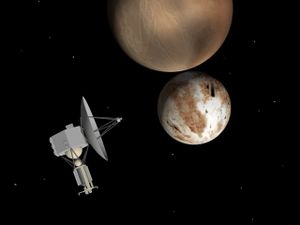
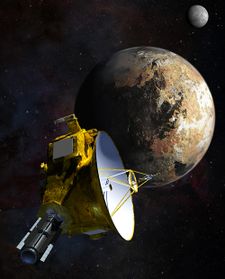
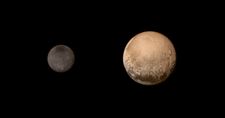

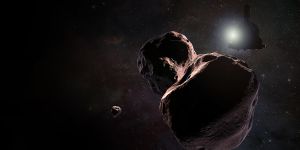

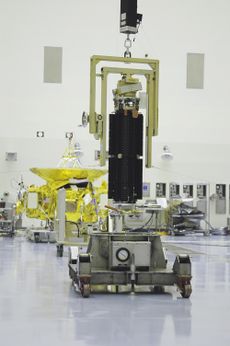
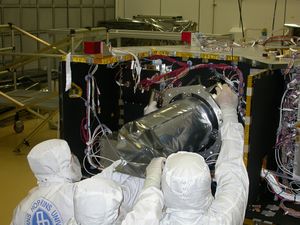



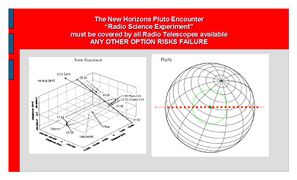
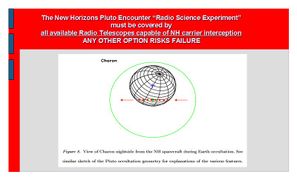
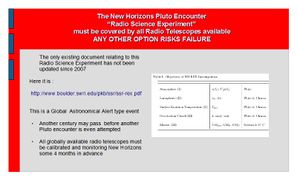
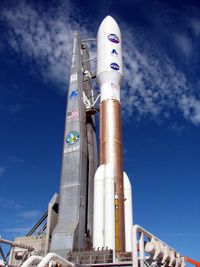











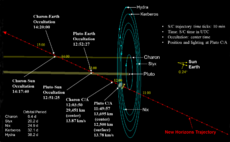
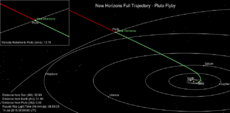



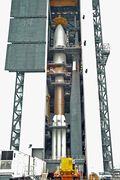
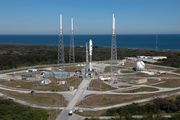
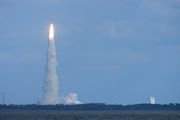
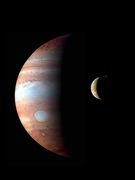
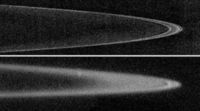
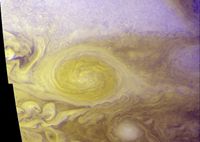



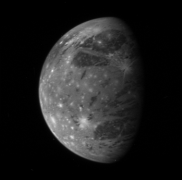
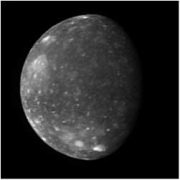
![April 2015: Pluto and Charon – first color image taken by Ralph during AP1 on April 9, 2015[19][20]](/w/images/thumb/5/5d/PlutoCharon-1stColorImage-NewHorizons-Ralph-20150414.png/150px-PlutoCharon-1stColorImage-NewHorizons-Ralph-20150414.png)
![May 2015: Pluto as seen by LORRI during AP2 from a distance of 75 million km away[21]](/w/images/thumb/b/b6/Pluto_by_LORRI%2C_12_May_2015.jpg/150px-Pluto_by_LORRI%2C_12_May_2015.jpg)



